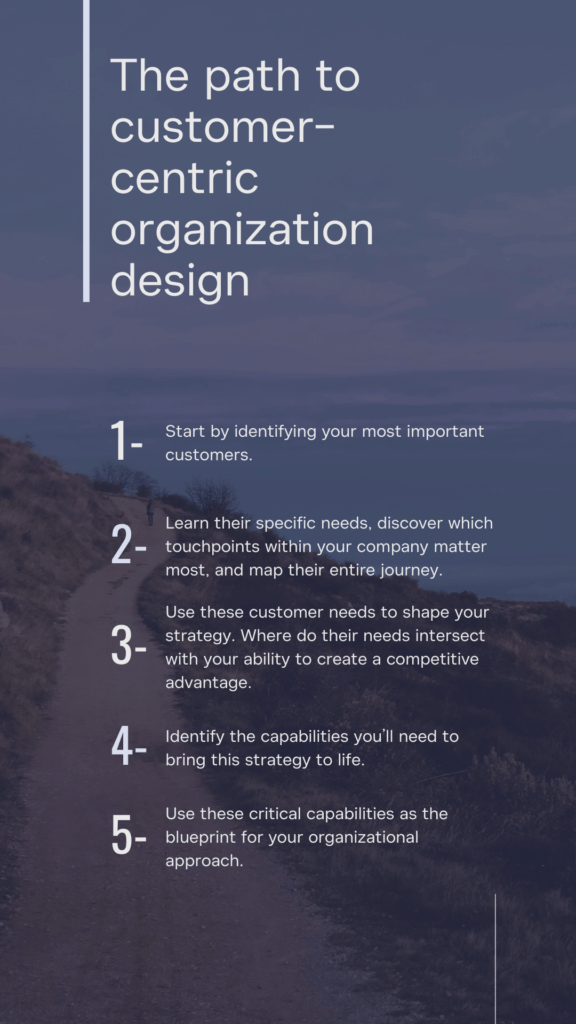Three years ago, I watched a software company spend eight months reorganizing around what they believed were their core strengths—engineering excellence, product innovation and market reach. The leadership team had countless whiteboard sessions mapping reporting structures, defining new roles and optimizing for internal efficiency. The result? A beautifully structured organization that completely missed what their customers valued most: seamless integration with existing workflows.
Six months after the reorganization, their largest client defected to a smaller competitor. Their “inferior” product simply worked better within the client’s existing processes. The competitor had organized their entire delivery model around integration expertise—not because they were naturally good at it, but because their customers told them it was make-or-break.
This story illustrates why most organizational redesigns begin with the wrong question. Instead of asking “How do we structure our teams?” we should be asking “Where do our customers need us to excel?” But here’s the critical nuance: the path from customer insight to organizational capability isn’t direct. It must flow through strategic clarity about how you plan to win in the marketplace.
The Strategic Bridge: From Voice of Customer to Winning Capabilities
Voice of customer (VOC) isn’t just input for organizational design—it’s the foundation. But there’s a crucial step that most companies skip: translating customer needs into a clear strategy for competitive differentiation, then using that strategy to identify the capabilities that truly matter.
This is where the “chicken and the egg” challenge emerges. Customer needs should absolutely inform strategy, but strategy must then inform which differentiating capabilities are worth developing. Without this strategic filter, you risk cherry-picking from customer feedback and building capabilities that either don’t meaningfully differentiate you or exceed your organization’s ability to develop effectively.
Start With Your Most Critical Customer Personas
Before drawing a single box on an org chart, invest time in understanding your customers. Not the broad segments you market to, but the specific personas whose success determines your success. These aren’t just demographic profiles—they’re detailed portraits of the people who interact with your organization at every touchpoint.
Ask yourself:
- Which customer personas drive the most value?
- Which ones have the highest growth potential?
- Which ones are most at risk of defection?
These personas should become your North Star for organizational design decisions.
Uncover Their Specific, Unvarnished Needs
Once you’ve identified your critical personas, dive deep into their world. What keeps them up at night? What makes their day easier? What frustrates them about working with companies like yours? The key is moving beyond what customers say they want. You must understand what they need to be successful.
Use a combination of direct feedback, behavioral data and observational research. Look for the gaps between what customers say and what they do. These insights will reveal potential areas where your organization might excel—but they’re not yet your organizational blueprint.
Customer Journey Development: The Foundation of Strategic Clarity
Before diving into organizational implications, let’s establish the fundamentals of effective customer journey mapping. A well-developed customer journey goes far beyond a simple funnel. It’s a comprehensive view of every interaction, emotion and decision point your customers experience.
- Start with the customer’s perspective, not yours. Traditional journey maps often reflect internal processes rather than customer reality. Instead, begin with how customers discover, evaluate, purchase and use your solutions.
- What triggers their initial interest?
- What questions arise during evaluation?
- What obstacles do they encounter during implementation?
- Identify critical touchpoints and moments of truth. These are the interactions that disproportionately influence customer perception and loyalty. A delayed response during the sales process might signal poor future support. A confusing onboarding experience can undermine confidence in your solution’s value. These moments reveal where organizational excellence could matter most.
- Map emotions alongside actions. Customers don’t just move through logical steps—they experience frustration, excitement, confusion and relief. Understanding the emotional journey helps you identify where your organization might need to excel at empathy, clarity or reassurance.
- Look for the white spaces. The most revealing insights often exist between formal touchpoints. What happens after a proposal is submitted but before a decision is made? How do customers feel during implementation gaps? These spaces frequently reveal potential organizational design opportunities.
- Map their entire journey with your organization—from initial awareness through ongoing relationship management. This isn’t the marketing funnel you’re familiar with; it’s the full ecosystem of interactions, decisions and experiences that define your customer relationship.
Pay special attention to the moments that matter most. These are the points where customers form lasting impressions about your reliability, responsiveness and value. They often occur in the spaces between departments—exactly where traditional org structures create friction.
The Strategic Filter: From Customer Needs to Competitive Strategy
Here’s where most organizations stumble. They jump directly from customer journey insights to capability development without answering the fundamental strategic question: “How do we plan to win?”
Your customer research will reveal dozens of potential pain points and opportunities. But your organization can’t be exceptional at everything. The strategic challenge is determining which customer needs align with your unique ability to create sustainable competitive advantage.
This requires honest assessment of several factors:
- Market Position: Where do you compete effectively today, and where are you vulnerable?
- Organizational DNA: What are you naturally good at, and what would be a significant stretch?
- Resource Reality: What level of investment and organizational change are you prepared to make?
- Competitive Landscape: Where can you create differentiation that’s difficult to replicate?
The magic happens when customer needs intersect with your strategic opportunity to win. These intersections become your future-critical capabilities.
Identify Your Future-Critical Capabilities
Now comes the strategic pivot. Based on your customer journey analysis filtered through your competitive strategy, determine what your organization needs to be absolutely exceptional at to win. These aren’t your current strengths—they’re the capabilities that will differentiate you in the future and directly address your customers’ most pressing needs in ways competitors can’t easily match.
- Maybe it’s the ability to provide real-time, personalized communications—but only if that aligns with your strategic positioning and organizational capacity.
- Perhaps it’s creating frictionless buying experiences—but only if you can sustain that capability better than competitors.
- It could be delivering consistent value proposition messaging across all touchpoints—if that’s where your strategic advantage lies.
Whatever these capabilities are, they become the building blocks of your organizational design. But they’ve been vetted through both customer need and strategic viability.
Design the Organization Around Strategic Customer Success
Here’s where VOC, filtered through strategy, transforms from insight to action. Take those strategically-validated critical capabilities and use them as the blueprint for your organizational approach. Instead of organizing around functional silos or leadership preferences, you’re organizing around the specific ways you plan to create customer success that competitors can’t easily replicate.
This means creating teams, roles and reporting structures that optimize for your chosen customer outcomes. It means establishing metrics that reflect customer value in the areas where you’re strategically positioned to win. And it means designing processes that eliminate friction from the customer’s perspective in ways that reinforce your competitive differentiation.

The Way Forward
Putting VOC at the center of organizational design—filtered through strategic clarity—isn’t just about better customer experience. It’s about building a competitive advantage that’s nearly impossible to replicate because it’s rooted in deep customer understanding and strategic focus.
Your next organizational design should start with two sequential questions:
- Where do our customers need us to be great?
- Which of these needs can we address better than anyone else, and how does that create sustainable competitive advantage?
Everything else—reporting structures, role definitions, process flows—should flow from those answers.
The companies that get this right don’t just satisfy customers. They create customers who become advocates, partners and sources of sustainable growth. They build organizational capabilities that competitors struggle to match. In a world where customer expectations continue to rise, that might be the only organizational design strategy that truly matters.
What’s been your experience with customer-centric organizational design? I’d love to hear how you’ve incorporated VOC and strategic clarity into structural decisions in the comments below.





